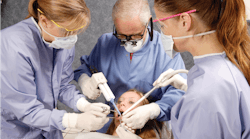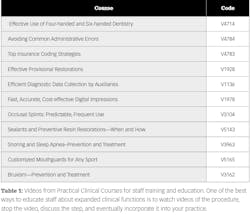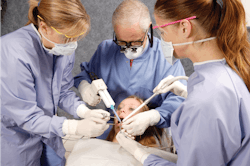Q: I am finding that expenses are rising for dental supplies and equipment, third-party payments are decreasing, patients are more hesitant to undergo elective treatment, and the slight annual inflation is not being compensated by interest rates. What can I do to at least stay level with my past net income and still accomplish quality dentistry for my patients?
A: I have heard the same thing from many practitioners who have the same challenges. Fortunately, there are some things you can do to improve your net revenue. I will offer a few methods to retain more of your gross income and how to accomplish these suggestions.
Increase clinical task delegation to your staff
You have undoubtedly heard me talk about this in the past. There are many tasks that can be legally delegated to educated, motivated staff persons. You probably wonder how you can educate staff to do some of the clinical tasks you now accomplish. You can send them to courses to learn the best methods for the tasks you want to delegate. You may prefer to use professional videos to educate your entire staff during staff meetings or specially arranged in-service education and training sessions. Some of the staff videos that are available from our organization, Practical Clinical Courses, are listed at the end of this article (table 1).
After a staff person has accomplished a specific task several times, he or she will be exited to be a more productive member of the team. I suggest that when staff members become competent in new tasks, you consider providing a bonus on each clinical day they accomplish the specific expanded function. This motivates staff to be more aware of the patients who need the procedure and to educate those patients.
Incorporating only a few of the tasks shown in Table 1 can increase gross revenue significantly and even double it with a much lower cost to perform the procedure.
Increase the knowledge and skill of your dental assistants
How do you accomplish this task? I suggest organizing several staff meetings aimed at the dental assistant and dental hygiene areas you feel could be improved in your office. Set up these meetings periodically. I prefer at least once per month for about 45-minutes. They can be held before you start a clinical day, during a noon luncheon meeting, or any convenient time you prefer.
What do you do in the meetings? You, a qualified staff member, or an invited visitor present the desired topic. You might even do the procedure personally to demonstrate it, or have each staff member do it, or watch a video on the topic and discuss it, or have each staff person do it. Have someone on your staff in charge of in-service education and training. Follow-up meetings are desirable to ensure that the staff can now accomplish whatever was taught.
You will soon find the procedures you have included in the meetings are visibly improved, faster, and more efficient. Be prepared to spend some time getting the meetings well-organized, on time, useful, and enjoyable.
Increase the speed of your clinical procedures by using six-handed dentistry
You are probably using four-handed dentistry, but have you learned how to work with six-handed dentistry? I will describe this concept and how to use it.
As you probably expect, under this arrangement the dental assistants must learn how to work together. Some dentists use the six-handed concept exclusively on difficult procedures, while others (including myself) use it most or all of the time. Done properly, the six-handed concept allows practitioners to produce dentistry faster and better with only a minimal increase in overhead.
Use the proper codes for your procedures
Periodically, new codes are introduced by the American Dental Association. Do you purchase the ADA code book? Do you have other coding references such as Coding with Confidence by Charles Blair, DDS, an expert on coding? This book is published each year with commentary on the codes and inclusion of the new ones. Tom Limoli of Limoli and Associates is another expert consultant on coding and administration.
New codes are developed frequently, and it is very easy to miss new codes when they are introduced if you aren’t watching for them. When you do not know about a new code, you can easily miss not only the code but also the remuneration it will provide for your practice.
Better knowledge about third-party payers and their policies
Your business staff should know the details about every company with which you work. Although each third-party payer has somewhat different contracts and rules, it is relatively easy for your staff to remain updated on the policies of the companies you use. Your business staff should educate all of your staff in formal meetings about the policies of the companies and how best to use them. This education allows your staff to do the things that will optimize the payments you receive from third-party payers.
Optimize the elective procedures on your current patients
Many dentists have a stable practice with a group of loyal patients who trust them, while other dentists are always trying to recruit new patients, often neglecting to educate their current patients about elective procedures.
I believe that performing complete treatment plans for current patients is a major way to optimize treatment plan acceptance. Unfortunately, most dentists do not do so. Divide treatment plans into mandatory procedures and elective procedures. Examples of mandatory procedures are ongoing caries or periodontal disease, broken teeth, and endodontics. Examples of elective procedures are veneers, adult orthodontics, tooth whitening, replacement of discolored or worn crowns, and many other procedures. Patients easily understand that the mandatory procedures need to be done. They may not want to do the elective procedures until a future time, but they are aware of the procedures that can be done.
Fully educating current patients is a major method to expand patient acceptance of treatment plans within the realm of your already loyal patients.
Enhance your collection policies
The front desk staff—especially schedulers—should know the average dollar amount per hour required to run the office and schedule accordingly (figure 2).
Negotiate supply costs with your local distributor
Distributors—Henry Schein Dental, Patterson Dental, Benco Dental, Burkhart Dental Supply, Goetze Dental, and many others—are a major and important part of the dental team. The local distributors visit several offices each day and provide you with information about products you cannot obtain otherwise. Negotiate with them to make an equitable arrangement financially for both your practice and the distributor.
Summary
Dentistry is a service profession, but adequate revenue is mandatory to run dental offices and pay dentists and staff. Because of reasons described in this article, dentists are making more gross revenue than in the past but taking home less net revenue. This article shows some of the methods to overcome this challenge. If dentists decide to use these proactive methods to increase practice productivity, then patients, dentists, and staff will benefit.
Author’s note: The following educational materials from Practical Clinical Courses offer further resources on this topic for you and your staff.
One-hour CE videos
- Top Ten Revenue Producing Expanded Functions (V4700)
- Multiple Patient Scheduling—Working Smarter, Not Harder (V4794)
- Optimizing Dental Hygiene to the Next Level (V4799)
Two-day hands-on courses
- Faster, Easier, Higher Quality Dentistry with Gordon Christensen
- Restorative Dentistry 1: Restorative, Esthetic, and Preventive Dentistry with Gordon Christensen
23-topic patient education video series
- Simple Patient Education for Every Practice
For more information about these educational products, please call (800) 223-6569 or visit pccdental.com.
Gordon Christensen, DDS, PhD, MSD, is a practicing prosthodontist in Provo, Utah. He is the founder and CEO of Practical Clinical Courses, an international continuing education organization founded in 1981 for dental professionals. Dr. Christensen is cofounder (with his wife, Rella Christensen, PhD, RDH) and CEO of Clinicians Report.










